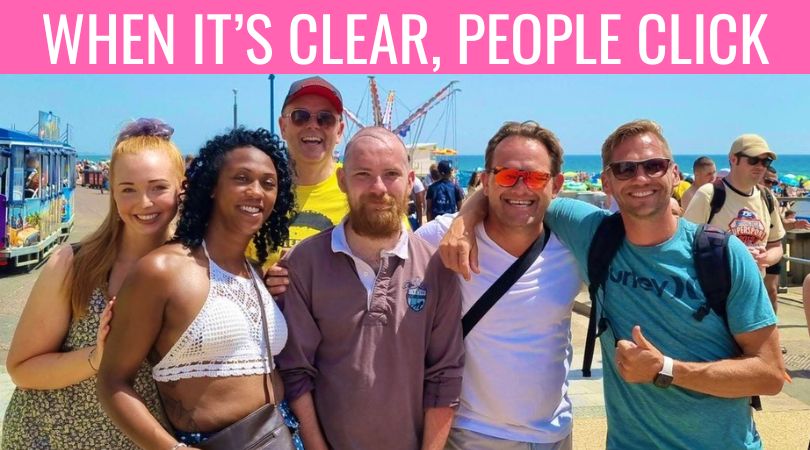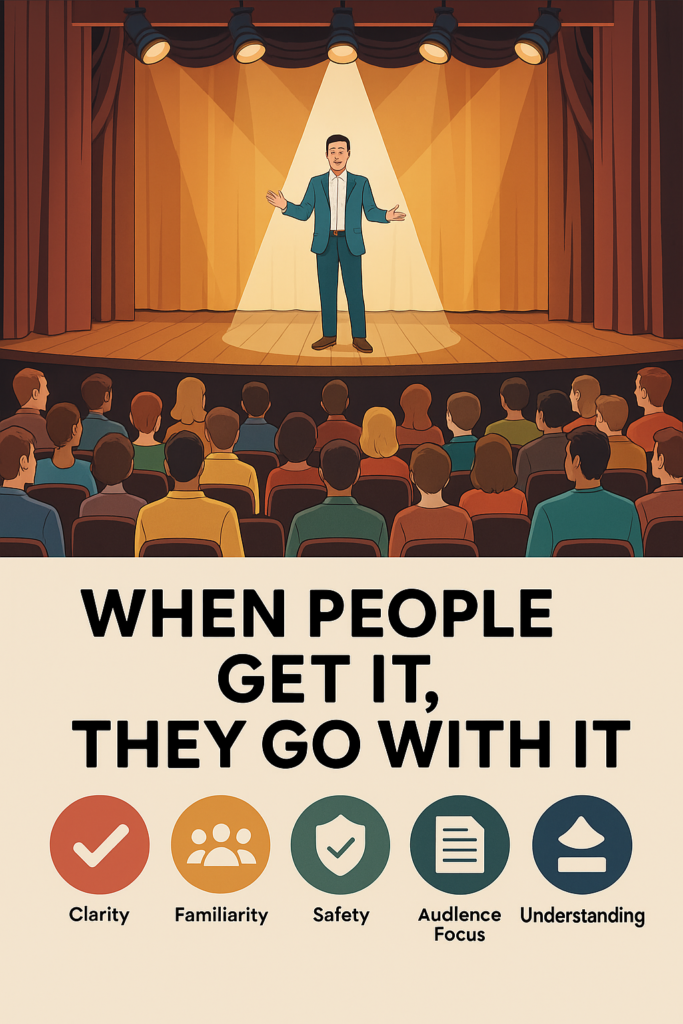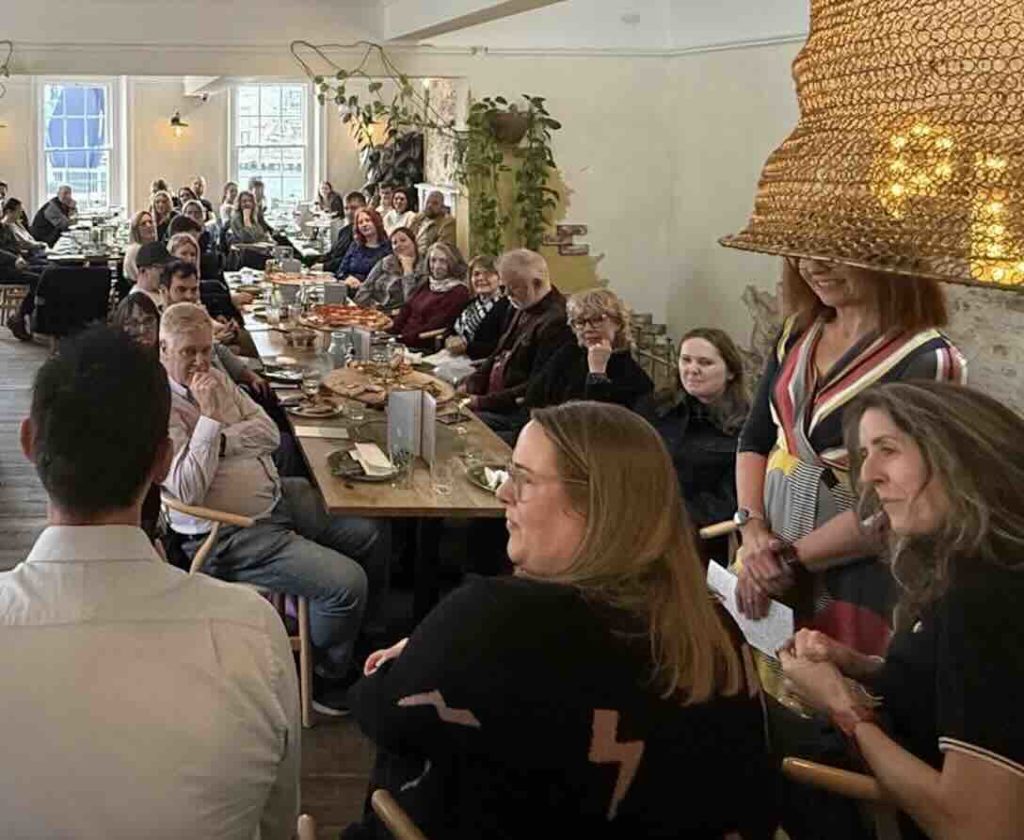Let’s learn and create together!
Book your placeIf People Don’t Get It, They Won’t Go With It

People don’t resist because they don’t care, they stop because they’re unsure of what they are being asked to do.
We put a lot of effort into what we say, but not enough into making it easy for others to understand.
For the past few years, the latter section of Creator Day is a moment for people to come together. For something that is new, it’s taken a lot of figuring out, so people feel comfortable.
Let me share how I have figured this out for people to join in with you.
Current Work To Share With You
I am currently working on the final touches for Creator Day, and specifically the Work Together section of the day.
This is where people split into small groups to create something of their own. No one sits back. People are invited to contribute. It’s collaborative, practical, and one of my favourite parts of the day.
As this is a new format for so many people when it comes to conferences, you have to approach what feels new in a different way.
But here’s the thing I’ve learned over time: if people don’t get it, they won’t go with it.
I’ve changed myself over the years. I assumed everyone would be as excited about the idea as I was when it was delivered for the first time. It is not the case.
When we started the Work Together format in 2022, my enthusiasm may have confused. I can remember having to explain to many people what to do whilst they were in their groups. I can picture the blank look on people’s faces the first time we did it. The reason was people didn’t get it. That wasn’t their fault, it was mine.
Enthusiasm can’t fill in for understanding. New formats, especially ones that ask people to contribute, need guidance. They need clarity. They need to be made obvious.
It’s not about what you want to say. It’s about what people need to hear.
The Problem With Being Clever
A lot of what I have delivered over the years has been propelled by my own belief that something can work. That doesn’t mean that other people are on board.
We often dress up ideas because we want to sound professional, creative, or smart. We want people to see the value and make that connection straight away. But in doing that, we can wrap our messages in too many layers.
And then we’re surprised when people decide to not take part.
The truth is, clarity carries more weight than cleverness. If people don’t understand what they’re being asked to do, or why it matters, they won’t take that next step. They’ll hesitate, unsure of how to proceed.
This doesn’t mean dumbing things down. It means making adjustments to get to a place where it feels easy and more assured to commit. Helping people see themselves in the idea. Helping them feel safe enough to join in.
The Power Of Familiarity
Concepts land when we make them feel familiar.
People are hesitant when what you say isn’t clear with how it fits into their world. And when your narrative feels unclear or uncomfortable, people protect themselves by staying on the edge.
Each year I want to make the Work Together part of Creator Day feel like a point when people are ready to step up. It’s at the end of the day around 3pm and our last step of focus before we all kick back with photos, chat and before we head to the after party.
Let me explain how it’s changed and what I’m doing to make something that feels new to people, to be accepted as ok.
It’s not complicated, but it is different and active. Everyone participates, though it’s a voluntary part of the day.
What is different this year is that it is woven as part of the occasion, it’s explained on the website with it’s own page, it is highlighted in the fortnightly emails to attendees and I need to explain during the day of the event, rather than at the end.
I know that it will only work:
- If people understand what they’re stepping into
- If they feel prepared
- If the room is set up to help them succeed.
This year, what I did was not just be prescriptive and just explain the format, I made it feel normal. I said things such as:
- “This is a chance to explore an idea together.”
- “You don’t have to be perfect or it to look perfect, you just need to have a go.”
- “We’re in this together, let’s make something happen.”
Small shifts. Simple words. But the intention is to help the unfamiliar feel safe. That’s when people step forward.
Say What People Need To Hear
This has been a long lesson for me and maybe for you too.
We become so intertwined with the work we are proud of and put thought and effort into that we forget what the audience needs to hear. It was about them, it was about all of us.
Not more. Not louder. Just clearer.
Here’s what I now ask myself before anything goes out:
- “Would someone who is not familiar understand this?”
- “Where might people feel unsure?”
- “Have I made it easy for someone to see what they can do?”
The moment it clicks for someone, the moment they get it, that’s when participation starts.
That’s what I want to build with YATM. I don’t want to have an audience that just watches, I want a community that joins in.
Participation Starts With Understanding
When people understand what something is for, they join in.
When they know what’s expected, they step up.
When they feel part of the rhythm, they bring their own energy.
That’s how collaborative work happens. That’s how communities are built. Not through impressive language, but through inviting participation. It’s not through complicated formats, but through accessible ones. And not by trying to control everything, but by guiding just enough that people feel confident to take part.
I’ve said this before, but it feels truer now than ever: participation is the product. And participation starts with understanding.
How You Help People Get It, So They Go With It
Here are five ways I have changed over the years by tweaking what the audience needs to hear.
1) Clarity Beats Cleverness
What I now know: Don’t wrap your message in creative jargon or metaphors that you think are clever.
2) Make New Feel Familiar
What I now know: Anchor new ideas in a language and structure people already understand.
3) Guide People, Don’t Overwhelm
What I now know: Make people feel safe so they can step in confidently.
4) Speak To What People Need to Hear
What I now know: Shift from self-expression to audience clarity. Focus on what helps other people act.
5) Understanding
What I now know: When people understand how it’s going to be of benefit, they join in.

Let’s Round-Up
There’s something quietly empowering about calming down intense enthusiasm.
Clarity is respectful. It conveys that I’ve considered how this affects you. It indicates that you’re not merely trying to prove a point or perform, but rather, you’re aiming to connect.
That’s the work. That’s the shift. From “this is what I’m saying” to “this might help people get involved.”
If people don’t get it, they won’t go with it.
But when they do get it, when the message feels familiar, relevant, clear they go further than you ever expected.
The goal is to keep making it easy for people to show up and say, “I’m in.”
Build Your Community
A brand new programme from Mark Masters for businesses wanting to make that next growth step.
Find out moreYATM Club
Where non-conformist business owners come to work, learn and make friends. Click here

